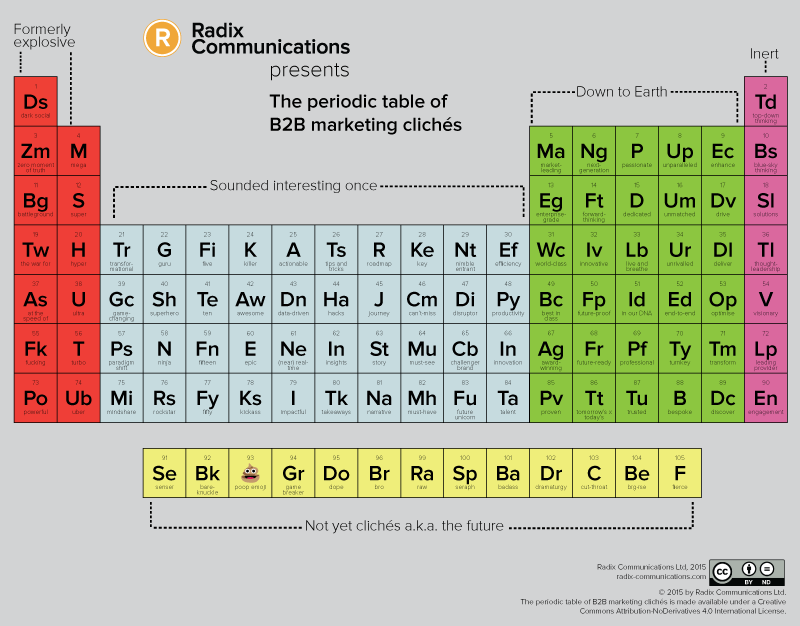Brief even the world’s greatest copywriter badly, and they won’t deliver what you need.
The words they tap out won’t appeal to the right people. Or talk about the right thing. Or fit where you want to put them.
You might as well scrape them off your homepage and replace them with some significant-looking geometric shapes, or vaguely aspirational go-faster stripes. If they’re for a standalone content piece – like an eBook, or a SlideShare – there’s every chance it’ll end up languishing among the estimated 60+ percent of B2B content that gets created, but never actually used.
And yet… a lot of the briefs a B2B copywriter receives are woefully inadequate.
At a recent Twitter chat, we asked the assembled copywriters (TM pending) to share the biggest issues they have with the briefs they receive. Here are two representative responses:
@radixcom A1: The fact that many customers know they *need* copy, but they have no idea what they want to achieve #b2bcopychat
— Ben Lloyd (@Techwriteuk) May 3, 2016
A1 Lack of clarity as to who the target readers are/what they already know/ what their burning questions are. #b2bcopychat
— Jonathan Tee (@Jon_Tee) May 3, 2016
And these are not lone voices in the wilderness. These are the cries of an army of professionals, desperately wanting to do a good job – so they can earn your repeat business, sure, but also so they can take some genuine pride in their work.
So, how do you brief well, and give a huge boost to both your marketing efforts and your copywriter’s self-esteem?
Here’s my take on the absolute fundamentals.
1. Help us understand who we’re writing for. (The audience.)
You know the kind of person you want to reach:
- Where they work
- What they do
- What keeps them lying awake at night
- What makes them gaze droolingly into the middle distance
- What job title they’d ultimately like to call their own
- What they already know (and don’t know) about your product or service
So, tell your copywriter. It’s a lot easier to be persuasive when you know who you’re talking to.
If you don’t know who your audience is, or you genuinely think your audience is ‘everyone’, you’re talking to a copywriter too early. Instead of rushing to produce content, you should be working to refine your marketing strategy.
In our Twitter chat, Dave Harland @wordmancopy succinctly summarised the kind of brief that’s guaranteed to make a copywriter’s heart sink:
Q:How old are they?
A: 0-100Q Male or female?
A: yes.#b2bcopychat— Dave Harland (@wordmancopy) May 3, 2016
(Even better than telling us about your customers, you could introduce us to them.)
2. Tell us where the audience will read our copy.
That ‘where’ is both physical – on this blog, in an email that follows this template – and metaphorical. If you’re mapping your content to the good old sales and marketing funnel model, or it’s part of a larger campaign, let us know where it’s going to sit.
That way, we can make sure our copy forms a neat, logical journey, and even helps you effectively qualify leads along the way.
3. Explain how you speak, what you want to say, and why your audience should care.
Whether you’re producing a series of thought-leadershippy blog posts, or a thoroughgoing product guide, you’re producing it to engage your audience, and tell them something.
All you need to tell your copywriter is:
- How you speak – if your company has a tone of voice guide, share it with us now
- What you want to say – whether it’s ‘Hey, have you thought about how you’ll handle all the data from the Internet of Things?’ or ‘This is how our software helps businesses hire faster’
- Why our audience should care – which of their challenges, worries and dreams does your message speak to?
4. Tell us what you want the audience to do next.
Thanks to the multiple teams, stakeholders and pressures involved in the creation of most marketing content and campaigns, it’s all too easy for the ‘call to action’ – what you actually what your audience to do after reading the copy – to be finalised very late in the day.
Ideally, however, it’s there from the start, front-and-centre in the brief. That way, your writer can create copy that carefully builds towards it – until taking that next step seems like the only natural thing to do.
5. Lay down the briefing law.
As our Twitter chat revealed, different writers like to be briefed in different ways. You could ask them for their preference. But you’re probably better off covering all bases:
- Put together a written brief. This needn’t take long. The stuff you’ll want to include – from who the audience is, to how the copy is going to be used – is all stuff you should know already. Putting it in a Word doc will help you nail it down, and highlight any gaps or issues. (And once you’ve written your first brief, you’ve got a template you can use again and again.)
- Arrange a briefing call. It doesn’t matter how comprehensive your written brief is, a good writer will relish the chance to hear you explain the project—and to ask questions.
- Arrange further calls, if necessary. Some projects will require your writer to understand and convey complex ideas, others to present genuinely expert advice. If that’s the case, give us a chance to quiz the people with the ideas and/or knowledge. (Often, this means product experts.)
6. Give feedback.
If you’re working with a writer on a series of projects, the feedback you offer becomes a crucial part of the briefing process. Tell us if we met the brief. Tell us if you felt you had to tweak the tone of voice, or cut our hilarious play on words. Tell us if a project has met its targets, and if not, where it’s failed.
This is the kind of information copywriters thrive on. It helps us correct, perfect, and ultimately do an even better job next time.
Here’s the simple truth, and one that few will be honest enough to tell you.
Great copywriters can use their skills in two ways.
If you brief us badly – something the best of us will fight tooth and claw to stop from happening – we’ll reluctantly use our writing prowess to paper over the cracks in our understanding. We’ll produce words that read just fine, whoever’s reading them, and neatly fill some space. But that’s all they’ll do. They won’t hit home with your audience. They won’t make them sit up and take notice – and action.
And we’ll feel bad about it, even though we’ve done a bloody miraculous job under the circumstances.
But if you brief us well, it’s quite literally a different story.
We’ll use our skills to engage the people you’ve told us you want to engage. We’ll have the grounding and the confidence to write with genuine authority, find resonant narratives, and bring the full force of your expertise and our creativity to bear.
We’ll make any organisation look as clever as it is – if not more so – and its products or services look as invaluable as they are. Which is, after all, why you went looking for a great B2B copywriter in the first place.
All I’m saying is this. Let us show you what we can do.
For more B2B content tips…
Subscribe and listen to the Good Copy, Bad Copy podcast.


